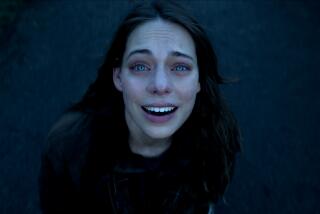Look, Up in the Sky ... Digital Troops
In the early days of pre-production on Episode 9 of HBO’s “Band of Brothers” miniseries, David Frankel, the episode’s director, debated with producers the wisdom of using digital effects to create disturbingly realistic images of concentration camp victims.
“The point is to show Easy Company soldiers getting over their bitterness about all the terrible things they have been through by reminding them of why they made such sacrifices,” says Frankel, who also directed Episode 2. “To do that, we wanted them to see the true horror of the camps. So we talked about portraying the survivors as emaciated as they really were--little more than skeletons with flesh on them, like old documentary footage from the war.”
The visual effects staff did tests and found they could achieve the emaciated look. The question then became, should the film make camp survivors look that terrible? “To be as realistic as possible, in that sense, we should, but on the other hand, this is not a documentary, and we didn’t want to take away from the dramatic effect of the story by overwhelming the audience,” Frankel says.
In the end, he decided to forgo digitally enhanced camp survivors. Instead, producers for the most part went the traditional route to create the illusion--expert makeup and costumes. But for some shots, they filmed motorized mannequins and, in one case, an animatronic elderly man with a few digital enhancements. “The old man is impossibly thin, and his eyes and mouth are the only things that move, so that approach worked for that shot,” Frankel says. “But there is simply no realistic way to accurately depict the true horror of concentration camps, even with digital advances.”
Still, “Band of Brothers” relies more heavily on the “digital option” than most television projects. Featuring more than 800 computer-built effects shots in the course of 10 episodes, the miniseries actually pursued an effects strategy more commonly associated with feature films than television. Producers enlisted London-based film veteran Angus Bickerton (“Lost in Space”) to serve as visual effects supervisor on the project, and they headquartered the effort at London’s Cinesite, which created many of the digital effects, while other shots were farmed out to facilities around the world.
Despite the computer’s power to offer new visual interpretations of the gruesome aspects of war, the digital work was largely environmental in nature. That effort was mainly designed to alter sets at the London production location--the Hatfield Aerodrome--to appear as wartime Paris, Germany, Belgium and elsewhere.
Other sequences digitally transformed small groups of actors into huge army columns, and created aerial dogfights, bombing raids and digital paratroopers “invading” Europe. Episode 9, titled “Why We Fight,” features 300,000 German soldiers surrendering to allied troops and then being marched down the Autobahn.
“We hardly had 300,000 Germans available,” Frankel says, “so we filmed 300 extras. The effects people then scanned those film plates into the computer and digitally cloned the 300 soldiers to make them appear like 300,000.”
Ken Dailey, co-digital effects supervisor at Cinesite, concedes that a portion of the show’s digital effects are now considered fairly routine in filmmaking, such as muzzle flashes, digital explosions and simple composites--essentially digital sewing jobs designed to seamlessly combine or layer separate live-action shots, or live-action and digital shots. Other sequences, however, were “as state-of-the-art as anything you’ll see in a feature film,” Dailey said.
“The parachute jump in Episode 4, when the Allies invade Holland, was difficult because parachutes are difficult to do with computer animation,” he explains. “We went on location for four days, shooting live-action, foreground action and some stunts showing parachute rigs landing, but filling the sky with parachutes was all done digitally. Our computer animation team used [computer-animation software tool] Maya to build parachute dynamics and the turbulence you normally see buffeting parachutes, and then that was added to computer parachute models.... It was pretty complicated stuff, even by today’s standards.”
More to Read
The complete guide to home viewing
Get Screen Gab for everything about the TV shows and streaming movies everyone’s talking about.
You may occasionally receive promotional content from the Los Angeles Times.






